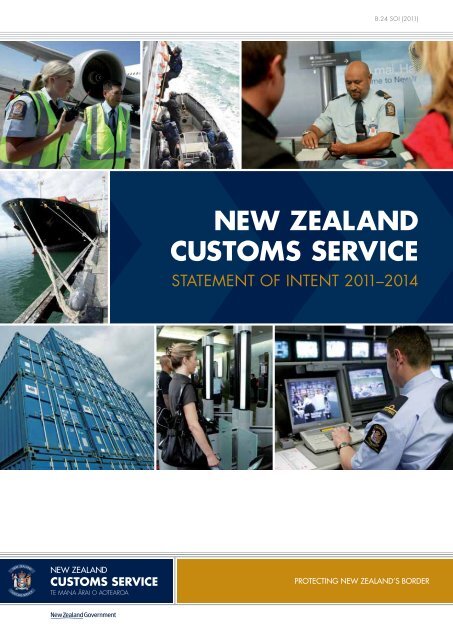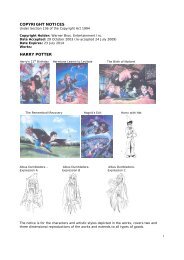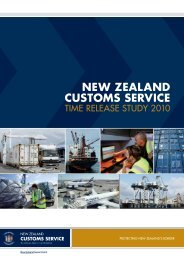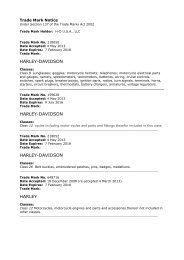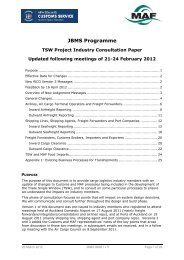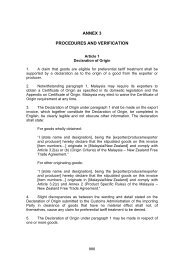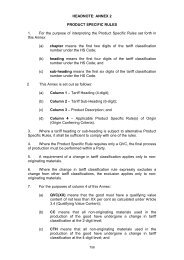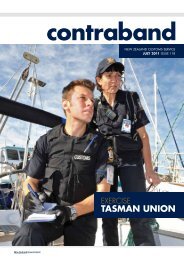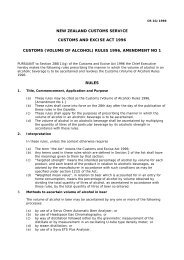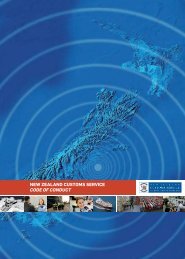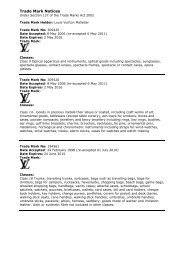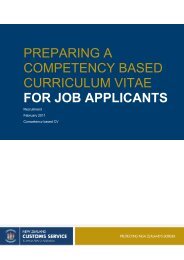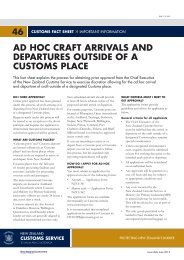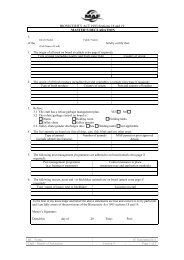Statement of Intent 2011-2014 - New Zealand Customs Service
Statement of Intent 2011-2014 - New Zealand Customs Service
Statement of Intent 2011-2014 - New Zealand Customs Service
You also want an ePaper? Increase the reach of your titles
YUMPU automatically turns print PDFs into web optimized ePapers that Google loves.
B.24 SOI (<strong>2011</strong>)NEW ZEALANDCUSTOMS SERVICESTATEMENT OF INTENT <strong>2011</strong>–<strong>2014</strong>
B.24 SOI (<strong>2011</strong>)STATEMENT OF INTENT <strong>2011</strong>–<strong>2014</strong>NEW ZEALAND CUSTOMS SERVICEPresented to the House <strong>of</strong> Representativespursuant to section 39 <strong>of</strong> the Public Finance Act 1989ISSN 1176 1857
CONTENTSMINISTER’S FOREWORD ................................................................................2COMPTROLLER’S INTRODUCTION .................................................................4NATURE AND SCOPE OF CUSTOMS’ FUNCTIONS .........................................6STRATEGIC DIRECTION ...................................................................................7CUSTOMS’ STRATEGIC FRAMEWORK ............................................................10CUSTOMS’ OPERATING ENVIRONMENT ........................................................12OUTCOME: PROTECTION ..............................................................................15Ministerial priority ......................................................................................15OUTCOME: TRADE ........................................................................................19Ministerial priority ......................................................................................19OUTCOME:TRAVEL ........................................................................................23Ministerial priority ......................................................................................23OUTCOME: REVENUE ...................................................................................26CUSTOMS’ ORGANISATIONAL HEALTH AND CAPABILITY ..........................28CAPITAL AND ASSET MANAGEMENT INTENTIONS ...................................33<strong>New</strong> <strong>Zealand</strong> <strong>Customs</strong> <strong>Service</strong> 1
MINISTER’S FOREWORDThe earthquakes in Japan and our own city, Christchurch, have sharpened the focus on a safe and secure<strong>New</strong> <strong>Zealand</strong>, and the Government’s aim to build a brighter future for <strong>New</strong> <strong>Zealand</strong>.<strong>Customs</strong> facilitates tradeand travel, supports<strong>New</strong> <strong>Zealand</strong>’s access tooverseas markets, andpromotes secure andefficient trade.These broader aims are supportedby the Government’s two key goalsfor <strong>2011</strong> to:»»build the foundations for a strongereconomybuild better results from the publicservices <strong>New</strong> <strong>Zealand</strong>ers rely on.<strong>Customs</strong>’ services and significantinfrastructure provide critical supportto <strong>New</strong> <strong>Zealand</strong>’s trade, tourism,and related safety and security; whilecollecting 15 percent <strong>of</strong> Crownrevenue. <strong>Customs</strong> facilitates trade andtravel, supports <strong>New</strong> <strong>Zealand</strong>’s accessto overseas markets, and promotessecure and efficient trade.To help the Government achieve itsgoals, I have agreed three priorities for<strong>Customs</strong> from <strong>2011</strong>/12, as follows:Streamlining and simplifyingtrade facilitation, and promotingsecure and efficient trade,particularly with Australia andChina aims to promote secure andefficient international supply chains,particularly to support <strong>New</strong> <strong>Zealand</strong>exporters. The aim is to increasebusiness confidence at the borderby delivering more reliable andpredictable border clearance processesfor <strong>New</strong> <strong>Zealand</strong> trade throughcustoms in <strong>New</strong> <strong>Zealand</strong> and overseas.Future work will enhance the progressalready made with Australia and China.The focus on developing andimplementing Stage 1 <strong>of</strong> the JointBorder Management System–TradeSingle Window (JBMS–TSW) with theMinistry <strong>of</strong> Agriculture and Forestrywill support this priority and <strong>Customs</strong>’activities. The TSW will make it easierfor <strong>New</strong> <strong>Zealand</strong> traders to completeborder requirements by providing asingle access point to border agencies.More efficient, streamlined, andsecure passenger facilitation,particularly for trans-Tasmanand Asia-Pacific travel is <strong>Customs</strong>’response to the expected increase intravel, particularly from Australia andthe Asia-Pacific. It aims to expand theprogramme for automated passengerclearance processes for trans-Tasmantravel; and provide more streamlinedand secure travel facilitation forarrivals from Australia, the Asia-Pacific, and other countries throughan improved approach to managingborder risks to <strong>New</strong> <strong>Zealand</strong>.Increase disruption <strong>of</strong> supply anddismantle criminal networks,particularly for illicit drugs andpeople smuggling, and maintainresponsiveness as risks changereflects this Government’s ongoingcommitment to disrupt the supply<strong>of</strong> methamphetamine or ‘P’, and itsprecursors, the chemicals used to make‘P’. Last year <strong>Customs</strong> seized nearlya tonne <strong>of</strong> precursors. The aim is tocontinue targeted activity to disruptthe supply <strong>of</strong> ‘P’; and a focus ondisrupting criminal networks throughan improved investigations approach,made possible by implementing newadvanced technology.This <strong>Statement</strong> <strong>of</strong> <strong>Intent</strong> shows how<strong>Customs</strong> intends to progress thesepriorities in the next three years, andits intended value to the Governmentand <strong>New</strong> <strong>Zealand</strong>’s trade and travel.2 <strong>Statement</strong> <strong>of</strong> <strong>Intent</strong> <strong>2011</strong>–<strong>2014</strong>
MINISTER’S STATEMENT OF RESPONSIBILITYAs the Minister responsible for the <strong>New</strong> <strong>Zealand</strong> <strong>Customs</strong> <strong>Service</strong>, I am satisfied that the information on futureoperating intentions provided by my department in this <strong>Statement</strong> <strong>of</strong> <strong>Intent</strong> and the Information Supporting the Estimatesis in accordance with sections 38, 40, and 41 <strong>of</strong> the Public Finance Act 1989 and is consistent with the policies andperformance expectations <strong>of</strong> the Government.Hon Maurice WilliamsonMINISTER OF CUSTOMS19 May <strong>2011</strong><strong>New</strong> <strong>Zealand</strong> <strong>Customs</strong> <strong>Service</strong> 3
COMPTROLLER’S INTRODUCTION<strong>New</strong> <strong>Zealand</strong>’s economy continues to be fragile as it responds to a slow recovery in the global economy, risingoil prices and infl ation, and the impacts <strong>of</strong> the recent devastating earthquakes in Christchurch. The economicand social costs <strong>of</strong> the earthquakes, including the slow down in tourism to the South Island, add to the uncertaineconomic environment <strong>New</strong> <strong>Zealand</strong> faces in the short term.<strong>Customs</strong>’ priorities supportthe Government’s aim tobuild a stronger economyand provide a public servicethat delivers results andvalue for money.<strong>Customs</strong> will remain agile in ourresponse. We will do what is necessaryto support the earthquake recovery;and meet changing service demandsas economic conditions change.Based on our efforts in recent years,we expect to be well-placed to meetincreasing demands and risks inthe medium term as the economyimproves, and as efforts to rebuildChristchurch accelerate.The Minister <strong>of</strong> <strong>Customs</strong> has agreedmedium term priorities for <strong>Customs</strong>relating to our services for Trade,Travel, and Protection. During the term<strong>of</strong> this <strong>Statement</strong> <strong>of</strong> <strong>Intent</strong>, <strong>Customs</strong>will give priority to delivering morestreamlined and simplified tradefacilitation, and more efficient andstreamlined passenger facilitation,particularly on trans-Tasman routes;while increasing disruption <strong>of</strong> thesupply <strong>of</strong> illicit drugs, particularlymethamphetamine or ‘P’ and itsprecursors, and managing otherborder risks.These priorities support theGovernment’s aim to build a strongereconomy and provide a public servicethat delivers results and value formoney, while managing withintight fiscal constraints. They alsosupport the shared commitmentwith Australia to accelerate effortstowards increasing economicintegration; the aspiration todouble trade with China by 2015;and the Government’s TacklingMethamphetamine: An Action Plan.Underpinning these priorities will besignificant changes in our operationalprocesses and the infrastructurethat supports them. These will bebased on efforts to further developand implement the Joint BorderManagement System–Trade SingleWindow; expand the SmartGateautomated processing system forpassengers on trans-Tasman routes;fully implement the IntegratedTargeting and Operations Centre;and implement advanced technologyto support our investigations. Wewill be a smarter and more efficientorganisation as a result, benefitingtraders and travellers.During the term <strong>of</strong> this <strong>Statement</strong><strong>of</strong> <strong>Intent</strong>, we will continue our longtradition <strong>of</strong> service to <strong>New</strong> <strong>Zealand</strong>,and work to increase the value thatthe Government and <strong>New</strong> <strong>Zealand</strong>ersreceive from our efforts.4 <strong>Statement</strong> <strong>of</strong> <strong>Intent</strong> <strong>2011</strong>–<strong>2014</strong>
COMPTROLLER’S STATEMENT OF RESPONSIBILITYIn signing this statement, I acknowledge that I am responsible for the information contained in the <strong>New</strong> <strong>Zealand</strong><strong>Customs</strong> <strong>Service</strong> <strong>Statement</strong> <strong>of</strong> <strong>Intent</strong> <strong>2011</strong>–<strong>2014</strong>. This information has been prepared in accordance with the PublicFinance Act 1989. It is also consistent with the proposed appropriations set out in the Appropriations (<strong>2011</strong>/12Estimates) Bill, as presented to the House <strong>of</strong> Representatives in accordance with section 13 <strong>of</strong> the Public FinanceAct 1989, and with existing appropriations and financial authorities.Martyn Dunne, CNZMComptroller <strong>of</strong> <strong>Customs</strong>Kevin MartinChief Financial Officer<strong>New</strong> <strong>Zealand</strong> <strong>Customs</strong> <strong>Service</strong> 5
NATURE AND SCOPEOF CUSTOMS’ FUNCTIONSCUSTOMS ENHANCESNEW ZEALAND’S PROSPERITYAND SECURITYThe <strong>New</strong> <strong>Zealand</strong> <strong>Customs</strong> <strong>Service</strong>(<strong>Customs</strong>) performs three broadfunctions to enhance <strong>New</strong> <strong>Zealand</strong>’sprosperity and security. We protect<strong>New</strong> <strong>Zealand</strong>’s border, facilitatelegitimate trade and travel, and collectCrown revenue, while managingrelated risks.<strong>Customs</strong>’ functions are reflected inthe <strong>Customs</strong> and Excise Act 1996and related regulations. A further45 principal Acts and other borderlegislation underpin these functions.OUR SERVICES<strong>Customs</strong> delivers a range <strong>of</strong> services,such as:» clearance and enforcementservices relating to people, goods,and craft crossing the border.Our services facilitate trade andtravel, and protect <strong>New</strong> <strong>Zealand</strong>’sinterests, where we:››clear people and theirpossessions through directinteraction or self-clearancetechnology, and collectinformationclear goods, and provide tradeand supply chain securityassurance»»information, intelligence, andrisk assessment services toexternal clients to protect<strong>New</strong> <strong>Zealand</strong>’s security. Thisincludes the operation <strong>of</strong> theNational Maritime CoordinationCentre (NMCC), which supportsa whole-<strong>of</strong>-government effort toadvance <strong>New</strong> <strong>Zealand</strong>’s maritimeand marine interests. The NMCC’sservices include the tasking <strong>of</strong>government’s maritime assets forcivilian surveillance and response;and information and adviceto improve maritime domainawareness 1policy advice and internationalservices, obligations andassistance, and ministerial support.»››clear craft arriving in anddeparting from <strong>New</strong> <strong>Zealand</strong>apply a range <strong>of</strong> interventions,investigations, audits, andenforcement activities tomanage border and revenuerisksrevenue collection services, wherewe receipt and process revenuesowed to the Crown for <strong>Customs</strong>and other agencies; and providerevenue assurance, and credit anddebt managementAll functions are within the scope<strong>of</strong> Vote <strong>Customs</strong> and defined withinthe output class descriptions detailedin the Information Supporting theEstimates for Budget <strong>2011</strong>. In <strong>2011</strong>/12,in delivering <strong>Customs</strong>’ services, weexpect to facilitate trade valued atmore than $85 billion; facilitate travel<strong>of</strong> more than 10 million people; andcollect over $10 billion, or 15 percent<strong>of</strong> Crown revenue. These functions,services, and <strong>Customs</strong>’ strategy forthe next three years are detailed in thefollowing pages.1 The NMCC is an operational unit within <strong>Customs</strong>, working on behalf <strong>of</strong> a number <strong>of</strong> government agencies with interests in maritime surveillance and response. The NMCC alsoprovides agencies with information and advice to improve maritime domain awareness.6 <strong>Statement</strong> <strong>of</strong> <strong>Intent</strong> <strong>2011</strong>–<strong>2014</strong>
STRATEGIC DIRECTIONTHE GOVERNMENT’S AIMSThe Government’s aim to build a brighter future for <strong>New</strong> <strong>Zealand</strong> is characterised by improvedemployment, incomes, living standards, and wellbeing.Two key goals for the Government in <strong>2011</strong> that support this aim are: build the foundations for a stronger economy,based on enduring growth and better results from the public services <strong>New</strong> <strong>Zealand</strong>ers rely on, while deliveringvalue for money. Building a stronger economy involves three focus areas for <strong>2011</strong> — savings, investments, andexports; supported by economic conditions that help <strong>New</strong> <strong>Zealand</strong>ers to save and foster their confidence to investin and create new businesses, and help exporters to compete internationally. It is also supported by a further focuson building stronger Government accounts through reduced debt and spending restraints, including within thepublic sector.CUSTOMS’ OUTCOMESAND PRIORITIES<strong>Customs</strong>’ outcomes and priorities arealigned with the Government’s aims.To support our export economy, wewill work actively with industry andother agencies, both in <strong>New</strong> <strong>Zealand</strong>and internationally, to develop moreefficient and secure international tradeand travel supply chains, and morestreamlined processes.We will also continue to collect dueCrown revenue, a key contributorto the Government’s accounts.While doing this, we will continue toprotect <strong>New</strong> <strong>Zealand</strong> from the risksassociated with international trade andtravel, with a particular focus on illicitdrugs and people smuggling.We have revised <strong>Customs</strong>’ outcomesto reflect the impacts or effectswe seek for traders, travellers, andthe Government on behalf <strong>of</strong><strong>New</strong> <strong>Zealand</strong>. Priorities relatingto the Protection, Trade, and Traveloutcomes have been agreed withthe Minister <strong>of</strong> <strong>Customs</strong>.From <strong>2011</strong>/12, <strong>Customs</strong> will advance<strong>New</strong> <strong>Zealand</strong>’s prosperity and securityby focusing on the following outcomesand priorities:» Protection — <strong>New</strong> <strong>Zealand</strong> ismore safe and secure throughreduced risk to <strong>New</strong> <strong>Zealand</strong>’sinterests arising from internationaltrade and travelWe will give priority to increasingdisruption <strong>of</strong> supply and dismantlingcriminal networks, particularly forillicit drugs and people smuggling, andmaintaining responsiveness as riskschange» Trade — <strong>New</strong> <strong>Zealand</strong>’s tradeflows more freely throughimproved access to markets, andmore secure and efficient borderprocessesWe will give priority to streamliningand simplifying trade facilitation, andpromoting secure and efficient trade,particularly with Australia and China» Travel — Travel to and from<strong>New</strong> <strong>Zealand</strong> flows more freelythrough more secure and efficientborder processesWe will give priority to more efficient,streamlined, and secure passengerfacilitation, particularly for trans-Tasman and Asia-Pacific travelRevenue » — The rate <strong>of</strong> collection<strong>of</strong> due Crown revenue ismaintained for <strong>New</strong> <strong>Zealand</strong>.<strong>New</strong> <strong>Zealand</strong> <strong>Customs</strong> <strong>Service</strong> 7
By focusing on these priorities,<strong>Customs</strong> seeks to deliver increasedvalue for the funding that theGovernment appropriates for borderservices. We are working to delivermore efficient and effective services,while leading work with border sectorcolleagues to improve border servicesand efficiency more broadly.We are adopting new approachesto service delivery. These involvestreamlining processes throughincreased integration with bordersector agencies and industry, andincreasing the use <strong>of</strong> modern andcapable technology. It also includesdeveloping a more integrated approachto managing border risk, which isexpected to improve the targeting <strong>of</strong>border risks, and increase efficienciesby improving resource allocation.The Government’s investments in theJoint Border Management System–Trade Single Window, the SmartGateautomated passenger processingsystem, and advanced technology tosupport our investigations approachare critical to improving our servicesand increasing our cost-effectiveness.COLLABORATION<strong>Customs</strong> collaborates with a range<strong>of</strong> others to achieve a variety <strong>of</strong>outcomes for <strong>New</strong> <strong>Zealand</strong>. We havethe most significant presence andinfrastructure at the border. We usethis to deliver services on behalf <strong>of</strong>a wide range <strong>of</strong> agencies, therebyreducing the number <strong>of</strong> agenciesthat need to have a physical borderpresence. We work with a number<strong>of</strong> government agencies to deliverprotection and facilitation services,while maintaining long-standingcollaborative partnerships.We are increasingly collaboratingwith industry to achieve more secureand efficient trade and travel, andimproved border services; and havesome significant partnerships inplace to achieve these ends. We alsowork closely with other governmentagencies and non-governmentorganisations overseas to advance<strong>New</strong> <strong>Zealand</strong>’s facilitation andsecurity interests.BORDER SECTORThe border sector was establishedby Cabinet in 2007/08. It comprisesagencies with responsibilities andinterests in <strong>New</strong> <strong>Zealand</strong>’s border. 2The governance structure for theborder sector promotes a whole<strong>of</strong>-governmentview <strong>of</strong> bordermanagement. The Border SectorMinisterial Group is driving theborder sector work programmeto ensure it aligns with theGovernment’s economic agenda.<strong>Customs</strong> currently chairs theBorder Sector Governance Group,comprising chief executives <strong>of</strong>member agencies.The border sector work programmeaims to provide a more seamlessservice to traders and travellers, whileincreasing efficiency and effectivenessfor both industry and government.The work programme is guidedby the border sector performanceframework. The two end outcomesfor the border sector are:2 Agencies <strong>of</strong> the border sector are the Department <strong>of</strong> Labour, Ministry <strong>of</strong> Agriculture and Forestry, <strong>New</strong> <strong>Zealand</strong> <strong>Customs</strong> <strong>Service</strong>, Department <strong>of</strong> Internal Affairs, andMinistry <strong>of</strong> Transport.8 <strong>Statement</strong> <strong>of</strong> <strong>Intent</strong> <strong>2011</strong>–<strong>2014</strong>
» Protection — <strong>New</strong> <strong>Zealand</strong> isprotected from people, goods, andorganisms that pose a risk to ourinterests» Facilitation — <strong>New</strong> <strong>Zealand</strong>’seconomic and social interestsare enhanced by facilitating thelegitimate flow <strong>of</strong> trade and travel.Border sector agencies also contributeto a number <strong>of</strong> shared intermediateoutcomes, which serve as buildingblocks to achieve these end outcomes.<strong>Customs</strong>’ outcomes <strong>of</strong> Protection,Trade, and Travel, and our impactsalign with the border sector endoutcomes. Our significant resourcesand presence at the border mean weare a key contributor to the bordersector outcomes, detailed below:OUTCOME INTERMEDIATE OUTCOME RELEVANT CUSTOMS’ IMPACTSProtection Deterrence » Maintained high levels <strong>of</strong> voluntary compliance» Increased disruption <strong>of</strong> illegal border activityInterceptionReducing harmIncreased disruption <strong>of</strong> illegal border activity» Reduced harm and potential harm from people and goods» Reduced risk from non-compliant travellers and goodsFacilitation Compliance costs Reduced compliance burden for tradersFacilitation <strong>of</strong> trade and travelReduced intervention with compliant traders, travellers, and goodsReputation See note below 33 <strong>Customs</strong> does not have an impact that relates directly to this intermediate outcome. However, trust and confidence in <strong>New</strong> <strong>Zealand</strong>’s border management system, the two keycomponents <strong>of</strong> reputation are measured for <strong>Customs</strong>’ Protection, Trade, and Travel outcomes.<strong>New</strong> <strong>Zealand</strong> <strong>Customs</strong> <strong>Service</strong> 9
CUSTOMS’ STRATEGIC FRAMEWORKVISION: Leadership and excellence in border managementthat enhances the prosperity and security <strong>of</strong> <strong>New</strong> <strong>Zealand</strong>MISSION: Protecting <strong>New</strong> <strong>Zealand</strong>’slive in safety, while actively participatingOUTPUT CLASSESIMPACTSInformationand intelligenceservicesPROTECTION» Reduced harm and potential harm from illicitpeople and goods» Increased disruption <strong>of</strong> illegal border activity» Maintained high levels <strong>of</strong> compliancePolicy advice andinternational servicesRevenue collectionREVENUE» Maintained and timely collection <strong>of</strong> due Crown revenue» Maintained high levels <strong>of</strong> voluntary compliance» Reduced intervention with compliant clients» Reduced risk from non-complianceClearance andenforcement servicesrelating to goodsTRADE» Increased access to overseas markets» Improved passage <strong>of</strong> <strong>New</strong> <strong>Zealand</strong> trade throughcustoms in <strong>New</strong> <strong>Zealand</strong> and overseas» Reduced compliance burden for traders» Maintained high levels <strong>of</strong> voluntary complianceClearance andenforcement servicesrelating to passengersand crewTRAVEL» Improved experiences for travellers throughborder processes» Maintained high levels <strong>of</strong> voluntary complianceClearance andenforcement servicesrelating to craftCAPABILITIESPeople Processes Information, Systems, and Technology10 <strong>Statement</strong> <strong>of</strong> <strong>Intent</strong> <strong>2011</strong>–<strong>2014</strong>
order and revenue in order that <strong>New</strong> <strong>Zealand</strong>ers mayin a global communityVALUES: » Integrity » Respect» Commitment » AgilityOUTCOMESPRIORITIESOPERATINGENVIRONMENTPROTECTION<strong>New</strong> <strong>Zealand</strong> is more safe andsecure through reduced risk to<strong>New</strong> <strong>Zealand</strong>’s interests arisingfrom international trade and travelPROTECTIONIncrease disruption <strong>of</strong> supplyand dismantle criminalnetworks, particularly for illicitdrugs and people smuggling,and maintain responsivenessas risks changeThe Government’s aims» build the foundations for astronger economy» better results from the publicservices <strong>New</strong> <strong>Zealand</strong>ers rely on,while delivering value for moneyREVENUEThe rate <strong>of</strong> collection <strong>of</strong> dueCrown revenue is maintainedfor <strong>New</strong> <strong>Zealand</strong>KEY TRENDS AND DRIVERSEconomic UncertaintyIncreasing Trade and TravelVolumes» Drive to increase trade with theAsia-Pacifi c region, particularlyChinaTRADE<strong>New</strong> <strong>Zealand</strong>’s trade fl owsmore freely through improvedaccess to markets, and moresecure and efficient borderprocessesTRADEStreamline and simplifytrade facilitation, andpromote secure andefficient trade, particularlywith Australia and ChinaIncreasing Risks andComplex Offending PatternsImproving the Environmentfor Business at the Border» Drive to progress a SingleEconomic Market with Australia» Drive for more secure andeffi cient global supply chainsTRAVELTravel to and from <strong>New</strong> <strong>Zealand</strong>fl ows more freely through moresecure and efficient borderprocessesTRAVELMore efficient, streamlinedand secure passengerfacilitation, particularly fortrans-Tasman and Asia-Pacific travelManaging Operational RisksRelationships<strong>New</strong> <strong>Zealand</strong> <strong>Customs</strong> <strong>Service</strong> 11
CUSTOMS’ OPERATING ENVIRONMENTECONOMIC UNCERTAINTYThe <strong>New</strong> <strong>Zealand</strong> economy continuesto be fragile. The lingering effects<strong>of</strong> the global economic recoveryare likely to be compounded bythe effects <strong>of</strong> the devastatingChristchurch earthquakes, and risksassociated with rising internationaloil prices and inflation. The globaleconomic recovery, while solid overall,continues to be patchy across some <strong>of</strong><strong>New</strong> <strong>Zealand</strong>’s trading partners.<strong>New</strong> <strong>Zealand</strong> expects to continue tobenefit from those performing well,particularly partners in Asia; whilemindful <strong>of</strong> the slow recovery forother trading partners, particularly inEurope and the United States, andthe reliance <strong>of</strong> <strong>New</strong> <strong>Zealand</strong>’s Asiantrading partners on those areas.<strong>New</strong> <strong>Zealand</strong>’s economic growthhas slowed in <strong>2011</strong>, exacerbatedby the Christchurch earthquakein February. 4 However, economicgrowth is expected to improve inthe next three years, particularlyfrom 2012. This includes a boost ineconomic activity through rebuildingefforts in Christchurch.Government finances will facecontinuing pressure in the short tomedium term. The already tight fiscalenvironment is likely to be affectedin the short term by increased costsin response to the earthquakes, anda reduced tax take owing to lowereconomic activity. This meansthat <strong>Customs</strong>, along with othergovernment agencies, can expect tocontinue to operate within tight fiscalconstraints. These constraints will alsoimpact on <strong>Customs</strong>’ ability to respondto other trends and drivers below.INCREASING TRADE AND TRAVELVOLUMESTrade and travel volumes willcontinue to rise in the short term,but this may not be to the extentpreviously forecast owing to anuncertain global economy andthe impacts on travel and tourismfrom the earthquakes in Japan,and Christchurch, <strong>New</strong> <strong>Zealand</strong>.However, trade and travel volumesare expected to increase in the nextthree years, particularly from 2012.Previous forecasts expected tourismto increase from a range <strong>of</strong> existingmarkets, with numbers doubling fromChina, and increasing from othercountries in the Asia-Pacific, includingJapan. 5 A spike in visitor numbers isexpected in the months leading to,during, and immediately following the<strong>2011</strong> Rugby World Cup. However,tourist numbers and travel associatedwith the export education sector arelikely to be affected, at least in theshort term.Against this backdrop, the driveto increase trade with the Asia-Pacific region, particularlyChina, is expected to contribute toa rise in trade and travel volumesin the medium term. Last year theGovernment announced its sharedaspiration to double trade with Chinain the next five years; with a focus onexports in particular.There is also increasing trade withrelatively new partners, such as Indiaand Viet Nam, and other partners,such as Korea, Japan, Malaysia, andSingapore; and interest from potentialpartners, such as Russia, Belarus, andKazakhstan; and Peru and the UnitedStates within the proposed expansion<strong>of</strong> the Trans-Tasman Pacific StrategicEconomic Partnership Agreement.INCREASING RISKS ANDCOMPLEX OFFENDING PATTERNSInternational trade and travel expose<strong>New</strong> <strong>Zealand</strong> to global threatsfrom trans-national organisedcrime, terrorism, weapons <strong>of</strong> massdestruction proliferation, and otherrisks. Changing trade and travelpatterns, particularly the increasedflows from countries that presenthigher levels <strong>of</strong> risk, need to bemanaged.4 The Treasury (<strong>2011</strong>). Monthly Economic Indicators. February. The Treasury: Wellington.5 Ministry <strong>of</strong> Tourism. (2010). <strong>New</strong> <strong>Zealand</strong> tourism forecasts 2010–2016: summary document. July. Ministry <strong>of</strong> Tourism: Wellington, p3.12 <strong>Statement</strong> <strong>of</strong> <strong>Intent</strong> <strong>2011</strong>–<strong>2014</strong>
<strong>New</strong> <strong>Zealand</strong> expects continuedchallenges from trans-nationalorganised crime, in particular thosegroups pr<strong>of</strong>iting from trade in illicitdrugs, people smuggling, and otherprohibited goods. The make-up <strong>of</strong>criminal groups, and their activitiesand <strong>of</strong>fending patterns are becomingincreasingly complex. This is makingit harder to detect crimes, identifysuspects, disrupt activities, andapprehend organisers behindcriminal networks.<strong>New</strong> technology is expected tosupport investigations <strong>of</strong> complex<strong>of</strong>fending more effectively. A focuson the finances <strong>of</strong> criminal groupsis also increasingly recognised as aneffective tool for disrupting illegalborder activity.IMPROVING THE ENVIRONMENTFOR BUSINESS AT THE BORDERThere is an ongoing drive toprogress a Single EconomicMarket with Australia. Australia is<strong>New</strong> <strong>Zealand</strong>’s largest trading partnerand the bulk <strong>of</strong> our internationaltravellers fly on trans-Tasmanroutes. <strong>New</strong> <strong>Zealand</strong> and Australiaacknowledge the importance <strong>of</strong> thecloser economic relationship to ourrespective future prosperity. It isreflected in a shared commitmentto accelerate efforts towards greatertrans-Tasman economic integration,and includes continued progress <strong>of</strong>the Single Economic Market agenda.There is a continued need to improvefacilitation that recognises the benefits<strong>of</strong> streamlined processes, supportedby modern technology to improveborder experiences for trans-Tasmantraders and travellers.Internationally, there is adrive for more secure andefficient global supply chains.While the need for effectivemanagement <strong>of</strong> trade security risksis recognised, it is also understoodthat unnecessary regulation andinefficient processes add to the costs<strong>of</strong> trade. <strong>New</strong> <strong>Zealand</strong> traders willsuffer competitive disadvantagesif they face a compliance burdenthat is higher than those <strong>of</strong> theircompetitors.To remain competitive, <strong>New</strong> <strong>Zealand</strong>must continue work to improve thesecurity and efficiency <strong>of</strong> its borderprocesses, and the predictability<strong>of</strong> processes operated by otheradministrations.ENVIRONMENTAL SCANNING<strong>Customs</strong> works in a dynamicenvironment and needs to monitorchanges to the operating environmenton an ongoing basis. This is done in anumber <strong>of</strong> ways:»»»on a daily basis as part <strong>of</strong> routineoperational managementthrough our intelligence processesand international connectionsthrough regular and periodicinteractions with industry groups» by preparing a longer-termstrategic outlook on an annualbasis.ORGANISATIONAL RISKSThe key trends and drivers withinthe operating environment presentopportunities and challenges to<strong>Customs</strong>. Failing to meet thempresents risks to <strong>Customs</strong>’ ability todeliver services effectively and achievethe impacts sought.We identify opportunities and risksduring our strategy developmentprocess. Organisational risks arefurther identified and refined inaccordance with <strong>Customs</strong>’ RiskManagement Framework, which setsout the procedures for managingorganisational risks and the standardsfor assessing risks. Our approachto risk also requires managers tocontinually identify, monitor, manage,and where necessary, report currentand emerging risks continually.The table over the page shows thelinks between the key trends anddrivers, opportunities and challengesfor <strong>Customs</strong>, organisational risks, andthe responses we propose to addressthem.<strong>New</strong> <strong>Zealand</strong> <strong>Customs</strong> <strong>Service</strong> 13
Key trends and drivers, opportunities and challenges, risks and our responseECONOMICUNCERTAINTYOPERATING ENVIRONMENT - KEY TRENDS AND DRIVERSINCREASING TRADE AND TRAVELVOLUMES» Drive to increase trade with theAsia-Pacific, particularly ChinaINCREASING RISKS ANDCOMPLEX OFFENDINGPATTERNSIMPROVING THE ENVIRONMENTFOR BUSINESS AT THE BORDER» Drive for more secure and efficient supply chains» Drive to progress a Single Economic Marketwith AustraliaOPPORTUNITIES AND CHALLENGES FOR CUSTOMSThe key trends and drivers create opportunities and challenges for <strong>Customs</strong> to improve our services.Provide coordinated borderservices to improve the tradeand travel fl ows throughcustoms in NZ and overseasProvide integrated processesand technology, and jointapproaches to risk withgovernment agencies andindustryProvide a moderncomputerised bordermanagement system, able tobe integrated with systemsoverseas to process trade andtravel efficiently, and assimilaterisk information quicklyTarget increasing risks fromtrade and travel, particularlyfrom countries that presenthigher risks, through moreintegrated intelligence andtargeting functionsInvestigate for longerand deeper into criminaloperations to unravel complexpatterns <strong>of</strong> <strong>of</strong>fending, andbring the organisers behindnetworks to accountORGANISATIONAL RISKSThe following present a risk to our ability to respond, and are listed in the order according to <strong>Customs</strong>’ organisational risk pr<strong>of</strong>ile.SYSTEMS, PROCESSES, PEOPLE ANDMANAGING OPERATIONAL RISKS» Fiscal pressures and increasing servicedemands mean we may not have the rightlevel <strong>of</strong> operations capability and capacityto deliver on large programmes <strong>of</strong> work,such as:› Joint Border Management System-TradeSingle Window› Increasing trade and travel, and related risks› Integrated intelligence and risk targetingthrough the Integrated Targeting andOperations Centre (ITOC)SYSTEMSThe prospect <strong>of</strong> notdelivering Stage 1<strong>of</strong> the Joint BorderManagementSystem programmein a cost-effectivemanner; andpotential failure <strong>of</strong>the current bordermanagement systemBORDER SECTORRELATIONSHIPSFailing to maintaineffective bordermanagementand stakeholderrelations to deliveron a sharedborder sector workprogrammeINFORMATIONThe possibility <strong>of</strong> notdelivering effectiveManagementInformationSystems, includingaccessible andtimely performanceinformation that tellsus how well we aredoing, and what weneed to improvePROCESSESThe prospect<strong>of</strong> not meetingincreasing demandfor automatedtrans-Tasman borderclearance fortravellers, therebyrelying on lessefficient manualprocesses to meetservice demandsINTERNATIONALRELATIONSHIPSFailing to developinternationalrelationshipsneeded to progress<strong>New</strong> <strong>Zealand</strong>’sborder interests forprotection, trade,and travel, such asrelations with China<strong>Customs</strong> to disruptsupply <strong>of</strong> precursorsOUR RESPONSEOur response to the opportunities and challenges, and risks we face:OUR PEOPLEImprove workforcecapability by continuinga flexible approach tomanaging ports, andleadership developmentPROCESSESMore streamlined andintegrated processeswith border agenciesto improve services andachieve efficienciesINFORMATIONImprove service deliveryand efficiencies bystrengthening ourperformance informationmanagement systemMANAGINGOPERATIONAL RISKSImprove targeting <strong>of</strong>resources through moreintegrated intelligencefunctions with theIntegrated Targetingand Operations Centre(ITOC); and improvedrisk assessmentcapability throughthe JBMSSYSTEMSContinue to develop the JBMS-TSW with MAF andother border agencies, and industry, to enable dataintegration across countries, agencies, and industry;and reduce the compliance burden for traders throughthe TSWImprove our investigations approach enabled byadvanced technology to disrupt smuggling <strong>of</strong> illicitgoods, dismantle criminal networks, and improveefficienciesContinue to streamline trans-Tasman border clearancefor travel with border sector agencies, including moreself-service kiosks (SmartGate) at key airports in NZRELATIONSHIPSWork closely, including in partnership with industry, and organisations and government agencies in <strong>New</strong> <strong>Zealand</strong>and overseas to progress <strong>New</strong> <strong>Zealand</strong>’s border interests14 <strong>Statement</strong> <strong>of</strong> <strong>Intent</strong> <strong>2011</strong>–<strong>2014</strong>
OUTCOME: PROTECTION<strong>New</strong> <strong>Zealand</strong> is more safe and secure through reduced risk to <strong>New</strong> <strong>Zealand</strong>’s interests arising frominternational trade and travel<strong>Customs</strong> protects <strong>New</strong> <strong>Zealand</strong> at theborder from a range <strong>of</strong> threats andrisks relating to international trade andtravel. 6 We also protect <strong>New</strong> <strong>Zealand</strong>from global threats posed by transnationalorganised crime, and thesmuggling <strong>of</strong> people and prohibitedgoods. In doing so, we balance theProtection outcome with those soughtfor Trade and Travel, so that ourefforts to protect <strong>New</strong> <strong>Zealand</strong> donot unduly delay the majority <strong>of</strong>legitimate trade and travel. <strong>Customs</strong>also protects the Crown revenue baseby actively managing non-compliance.The Protection outcome underpins allthat we do.All <strong>of</strong> our operations rely on our riskapproach. This approach is supportedby significant intelligence, processes,technology, and systems with riskassessment capabilities. Specifically,our risk approach contributes to thefollowing impact: maintained high levels<strong>of</strong> compliance, and additional impactsdetailed under the Ministerial prioritylater in this section.One <strong>of</strong> the ways that <strong>Customs</strong>manages risks is through our presence.We maintain our preparedness andability to respond to risks throughroutine patrols and exercises withother agencies in <strong>New</strong> <strong>Zealand</strong> andoverseas. We seek to understandrisks through a presence in areas weeither know little about, or need toupdate what we know. This involvesengaging with traders, travellers, andother parties, including governmentagencies and non-governmentorganisations in <strong>New</strong> <strong>Zealand</strong> andoverseas, to inform our intelligence.Our understanding <strong>of</strong> the riskenvironment enables us to decidewhether or not we need to reduceour presence in areas <strong>of</strong> low risk; andmaintain or increase our presence toinfluence levels <strong>of</strong> risk by detectingand deterring illegal activities.<strong>Customs</strong> promotes compliance anddeters <strong>of</strong>fending through directenforcement, investigations, andprosecutions. We deter <strong>of</strong>fendingby applying sanctions that areproportionate to the scale <strong>of</strong><strong>of</strong>fending.The Protection outcome is deliveredthrough services across fiveoutput classes for Vote <strong>Customs</strong>. 7These involve managing risks to<strong>New</strong> <strong>Zealand</strong> through clearingpeople, goods, and craft acrossthe border, while enforcing thelaw. We provide information andintelligence services to other agenciesthat contribute to <strong>New</strong> <strong>Zealand</strong>’ssecurity; and policy advice andinternational services to governmentagencies and non-governmentorganisations both in <strong>New</strong> <strong>Zealand</strong>and overseas.MINISTERIAL PRIORITYFrom <strong>2011</strong>/12, <strong>Customs</strong> will givepriority to the following, as agreedwith the Minister <strong>of</strong> <strong>Customs</strong>:Increase disruption <strong>of</strong> supplyand dismantle criminalnetworks, particularly for illicitdrugs and people smuggling,and maintain responsiveness asrisks changeWe will deliver this priority throughtwo initiatives:» Disrupt supply <strong>of</strong> illicit drugs,particularly methamphetamineor ‘P’ and its precursors»Combat the risk <strong>of</strong> peoplesmuggling, and risks associatedwith major international events.6 <strong>Customs</strong> counters threats and risks that include: trans-national organised crime linked to international terrorism, weapons <strong>of</strong> mass destruction proliferation, and other threats; illicitdrug smuggling and smuggling <strong>of</strong> other prohibited goods, such as objectionable material, and wildlife; people smuggling; Intellectual Property Rights infringements; fraud; Crownrevenue evasion; pandemics; and the illegal removal <strong>of</strong> Māori tāonga (treasured items) and other cultural heritage items from <strong>New</strong> <strong>Zealand</strong>.7 Clearance and enforcement services relating to passengers, crew, and their possessions; Clearance and enforcement services relating to goods; Clearance and enforcementservices relating to craft; Information and intelligence services; and Policy advice and international services.<strong>New</strong> <strong>Zealand</strong> <strong>Customs</strong> <strong>Service</strong> 15
Disrupt supply <strong>of</strong> illicit drugs,particularly methamphetamineor ‘P’ and its precursorsIMPACTS AND OBJECTIVES WE SEEKTO ACHIEVE 8From <strong>2011</strong>/12, we will seek to achievethe following impacts relating to thisinitiative:»»increased disruption <strong>of</strong> illegalborder activityreduced harm and potential harmfrom illicit people and goods.This initiative and related impactshelp us to deliver on our Protectionoutcome and to achieve safer<strong>New</strong> <strong>Zealand</strong> communities.It contributes to the Government’sNational Drug Policy 2007–2012,to reduce the supply <strong>of</strong> illicit drugsto the community; and theGovernment’s TacklingMethamphetamine: An Action Plan,with <strong>New</strong> <strong>Zealand</strong> Police to disruptand close down <strong>New</strong> <strong>Zealand</strong>’s‘P’ trade. We also aim for moreefficient and effective investigationsby implementing advancedtechnology.WHAT WE WILL DO TO ACHIEVETHESE IMPACTS AND OBJECTIVES<strong>Customs</strong> will continue targetedoperations and inspectionsexercises to disrupt the supply<strong>of</strong> illicit drugs, particularlymethamphetamine or ‘P’ and itsprecursors, the chemicals used tomanufacture ‘P’. This initiative is basedon recent success. In 2010, targetedoperations continued to intercept highquantities <strong>of</strong> ‘P’ and its precursors.This included 18.5 kg <strong>of</strong> ‘P’ seizedbetween January and October 2010,7.5kg more than in the same periodthe year earlier; and nearly a tonne(967kg) <strong>of</strong> precursors, equating indollar terms from $79 million to $110million <strong>of</strong> avoided harm.Our investigations approach todisrupt illegal activities seeks a stepchange in outcome and efficiency,supported by advanced technology.The technology will enable moreeffective investigations for lengthierperiods and deeper into criminalnetworks, and alleviate pressure onresources. Pressure points include thecapacity to undertake more complexinvestigations, and enquiries intoresource flows <strong>of</strong> criminal operations.Combat the risk <strong>of</strong> peoplesmuggling, and risks associatedwith major international eventsIMPACTS AND OBJECTIVES WE SEEKTO ACHIEVEFrom <strong>2011</strong>/12, we will seek to achievethe following impacts relating to thisinitiative:»»reduced harm and potential harmfrom illicit people and goodsincreased disruption <strong>of</strong> illegalborder activity.This priority and related impactsreflect the potential harm thatcould be caused to <strong>New</strong> <strong>Zealand</strong>’sreputation and economy by risksassociated with high-pr<strong>of</strong>ile, one-<strong>of</strong>fevents. The Government expectsagencies to be well prepared toidentify risks, and respond to themeffectively and efficiently. Thisincludes mounting a coordinatedcollective response to risks relatedto people smuggling, and majorinternational events such as theRugby World Cup.Over time, the investigationsapproach will apply to all prohibitedgoods, while recognising thatcriminal activities are <strong>of</strong>ten linkedand span across areas, such as moneylaundering, fraud, and the smuggling<strong>of</strong> weapons and illicit drugs. Wewill also investigate with a view todisrupting the financial flows <strong>of</strong>criminal operations.8 An impact is the direct societal, economic, or environmental change or effect made to an outcome by a specified set <strong>of</strong> outputs and/or actions.16 <strong>Statement</strong> <strong>of</strong> <strong>Intent</strong> <strong>2011</strong>–<strong>2014</strong>
WHAT WE WILL DO TO ACHIEVETHESE IMPACTS AND OBJECTIVESDuring <strong>2011</strong>, <strong>Customs</strong> will continuepreparedness exercises to respondto people smuggling, and potentialrisks relating to the Rugby WorldCup. In the medium term, <strong>Customs</strong>will continue to work with theDepartment <strong>of</strong> Labour and otheragencies in <strong>New</strong> <strong>Zealand</strong> and overseasto both monitor and prepareto respond to the risk <strong>of</strong> peoplesmuggling.From <strong>2011</strong>/12, we will support theimpacts sought by improving <strong>Customs</strong>’risk approach, particularly the linksbetween intelligence functions, risktargeting, and operational planning andcoordination, to enable more efficientresource allocation through theIntegrated Targeting and OperationsCentre (ITOC). 9 Over the mediumterm, we will support these effortsthrough advanced risk assessmentcapability within the Joint BorderManagement System, once developed.<strong>New</strong> <strong>Zealand</strong> is relatively safe, butas for other countries there is a riskfrom those who seek to disrupt largegatherings at major internationalevents. <strong>Customs</strong> will thereforecontinue to engage in multi-agencyexercises led by the <strong>New</strong> <strong>Zealand</strong>Police to respond to potential risksduring the <strong>2011</strong> Rugby World Cup.HOW WE WILL DEMONSTRATESUCCESSWe will demonstrate performancefor the Protection outcome as detailedbelow:Protection outcome measuresThe indicators demonstrate that <strong>New</strong> <strong>Zealand</strong> is well protected based on perceptions <strong>of</strong> <strong>New</strong> <strong>Zealand</strong> as a safe place.The second indicator reflects how <strong>Customs</strong> contributes to this perception.PROTECTIONOUTCOME STATEMENT INDICATOR MEASURE 10 BASELINE<strong>New</strong> <strong>Zealand</strong> ismore safe and securethrough reduced riskto <strong>New</strong> <strong>Zealand</strong>’sinterests arising frominternational tradeand travel<strong>New</strong> <strong>Zealand</strong>’s rankingin international risksurveys is maintainedPublic perceptions <strong>of</strong>border security threatsand risks 13<strong>New</strong> <strong>Zealand</strong>’s ranking for risk ratings asmeasured by indicative country comparisonsfrom the Economist Intelligence Unit’s RiskBriefing 11Public confidence that <strong>Customs</strong> protects<strong>New</strong> <strong>Zealand</strong> from external threats asmeasured by <strong>Customs</strong>’ stakeholder surveyAmong 12 the top 15 (thirdequal in 2009, out <strong>of</strong> 172countries)47-70% confidenceacross six dimensions asmeasured by <strong>Customs</strong>’2010 stakeholder survey9 The Integrated Targeting and Operations Centre is a multi-agency border sector headquarters, led by <strong>Customs</strong> and located within <strong>Customs</strong>. Currently, participating agencies includethe Ministry <strong>of</strong> Agriculture and Forestry, Department <strong>of</strong> Labour (Immigration), and Maritime <strong>New</strong> <strong>Zealand</strong>.10 The performance measures and standards cover the period <strong>2011</strong>-<strong>2014</strong>. Performance will be measured selectively in that period rather than annually.11 Country comparisons in international surveys and indices cover more than just customs activities.12 <strong>New</strong> <strong>Zealand</strong> is within a cluster <strong>of</strong> 15 countries that are rated as being <strong>of</strong> low security risk. The measure includes components around violent crime and organised crime –factors that are enabled by the availability <strong>of</strong> weapons, drug trafficking, and other organised crime.13 In the absence <strong>of</strong> frequent incidents, security is difficult to measure directly. Perceptions <strong>of</strong> security are included here because the survey draws on the knowledge <strong>of</strong> a largenumber <strong>of</strong> people about security in <strong>New</strong> <strong>Zealand</strong>.<strong>New</strong> <strong>Zealand</strong> <strong>Customs</strong> <strong>Service</strong> 17
Impacts for the Protection outcomePROTECTIONIMPACT 14 INDICATOR MEASURE AND TARGET BASELINEReduced harm andpotential harm fromillicit people andgoodsLevel <strong>of</strong> harm to the <strong>New</strong><strong>Zealand</strong> communityand national intereststhat is avoided through<strong>Customs</strong>’ drug seizuresThe value <strong>of</strong> harm avoided through <strong>Customs</strong>’drug seizures, as measured by indicative datafrom the <strong>New</strong> <strong>Zealand</strong> Drug Harm Index 15$92.15 million in2008/09Increased disruption<strong>of</strong> illegal borderactivityLevel <strong>of</strong> interdiction <strong>of</strong>illicit drugsIllicit drugs with a significant imported contentare harder to obtain compared with 2010/11as measured by the availability score in theIllicit Drug Monitoring System (SHORE) 16Availability <strong>of</strong> majordrug groups in 2006:methamphetamine, 1.8;crystal methamphetamine,2.1; LSD, 2.4; and Ecstasy,2.1Level <strong>of</strong> economic losssuffered by importers <strong>of</strong>illicit goodsImporters <strong>of</strong> illegal goods incur increasedlosses through seizure <strong>of</strong> illicit drugs, goodsinfringing Intellectual Property Rights (IPR)and other goods (loss in illegal gains basedon the estimated street value <strong>of</strong> drugs and theestimated market value <strong>of</strong> goods seized)To be establishedMaintained highlevels <strong>of</strong> complianceMaintained levels <strong>of</strong>compliance in areasthat currently have highcomplianceLevel <strong>of</strong> compliance found among small craft isat least 60%To be establishedMeasure <strong>of</strong> cost-effectiveness for the Protection outcomeDIMENSION MEASURE ESTIMATED BASELINEProtectionRatio <strong>of</strong> value <strong>of</strong> drug harm prevented as a percentage 74.29% in 2008/09<strong>of</strong> Vote <strong>Customs</strong> 1514 Inferences about impacts are based on the set <strong>of</strong> measures, rather than any single measure.15 <strong>Customs</strong> does not control the quantity <strong>of</strong> drugs and precursors that traffickers attempt to move across the border. There is currently no consensus on the volume <strong>of</strong> drugs inthe <strong>New</strong> <strong>Zealand</strong> market. Police estimates are an order <strong>of</strong> magnitude greater than epidemiological and economic estimates. Without such a consensus, <strong>Customs</strong> cannot provide acontext for this measure.16 SHORE is an acronym for the Centre for Social and Health Outcomes, Research and Evaluation, Massey University, Albany.18 <strong>Statement</strong> <strong>of</strong> <strong>Intent</strong> <strong>2011</strong>–<strong>2014</strong>
OUTCOME: TRADE<strong>New</strong> <strong>Zealand</strong>’s trade fl ows more freely through improved access to markets, and more secure and efficientborder processesManaging the border effectivelyenhances <strong>New</strong> <strong>Zealand</strong>’s reputation asa secure and reliable country to tradewith. <strong>New</strong> <strong>Zealand</strong>’s reputation iscritical to our ability to compete withother countries for trade.<strong>Customs</strong> work with others to protectour reputation and trade interests byassuring partners that <strong>New</strong> <strong>Zealand</strong>’sexports pose low risks to theircountries, and <strong>New</strong> <strong>Zealand</strong>’s bordermanagement is reliable, trustworthy,and efficient.We facilitate trade to and from<strong>New</strong> <strong>Zealand</strong>, and seek to managerisks in ways that do not cause unduedelays or costs to traders. <strong>Customs</strong>also supports <strong>New</strong> <strong>Zealand</strong> exportersto access overseas markets throughinput to <strong>New</strong> <strong>Zealand</strong>’s free tradeagreements, and by negotiatingcustoms partnerships with overseascounterparts.We implement and administer thecustoms aspects <strong>of</strong> these agreementsonce they are enacted or completed.Our agreements and relationshipshelp to improve the passage <strong>of</strong><strong>New</strong> <strong>Zealand</strong> trade through customsin <strong>New</strong> <strong>Zealand</strong> and overseas, whilemaintaining appropriate levels <strong>of</strong>security.The Trade outcome is deliveredthrough services across three <strong>of</strong> thesix output classes for Vote <strong>Customs</strong>. 17<strong>Customs</strong> clears goods at the borderthrough electronic import andexport entries for goods, and directinteraction.We maintain security through ourenforcement mandate and riskapproach. This approach relieson information, and integratedintelligence with risk assessmentcapabilities that target resourcesto areas <strong>of</strong> higher risk. It enables<strong>Customs</strong> to clear the majority <strong>of</strong>legitimate trade with little or nointervention at the border. <strong>Customs</strong>’policy and international servicesadvance <strong>New</strong> <strong>Zealand</strong>’s tradefacilitation and security interests.MINISTERIAL PRIORITYFrom <strong>2011</strong>/12, we will give priorityto the following, as agreed with theMinister <strong>of</strong> <strong>Customs</strong>:Streamline and simplify tradefacilitation, and promote secureand efficient trade, particularlywith Australia and ChinaWe will deliver this priority throughtwo initiatives:»Progress <strong>New</strong> <strong>Zealand</strong>’s free tradeagreements agendaProgress <strong>New</strong> <strong>Zealand</strong>’s freetrade agreements agendaIMPACTS WE SEEK TO ACHIEVE 18From <strong>2011</strong>/12, <strong>Customs</strong> will seek toachieve the following impacts relatingto this initiative:»increased access to overseasmarkets» improved passage <strong>of</strong> <strong>New</strong> <strong>Zealand</strong>trade through customs in<strong>New</strong> <strong>Zealand</strong> and overseas.These impacts contribute to theGovernment’s goal to build thefoundations for a stronger economy, andenduring growth, and its focus for<strong>2011</strong> on <strong>New</strong> <strong>Zealand</strong> exports.The initiative recognises that freetrade agreements (FTAs) are animportant mechanism for enablingmarket access for <strong>New</strong> <strong>Zealand</strong>exporters; while recognising theongoing challenge for <strong>New</strong> <strong>Zealand</strong>to increase exports and ensure webenefit from increased trade.»Promote secure and efficientinternational supply chains.17 Clearance and enforcement services relating to goods; Information and intelligence services; and Policy advice and international services.18 An impact is the direct societal, economic, or environmental change or effect made to an outcome by a specified set <strong>of</strong> outputs and/or actions.<strong>New</strong> <strong>Zealand</strong> <strong>Customs</strong> <strong>Service</strong> 19
WHAT WE WILL DO TO ACHIEVETHESE IMPACTSFrom <strong>2011</strong>/12, <strong>Customs</strong> willcontinue to negotiate procedureswithin <strong>New</strong> <strong>Zealand</strong>’s free tradeagreements (FTAs) to enabletransparent and prompt goodsclearance, and implement agreements,once in force, to improve the passage<strong>of</strong> trade. <strong>Customs</strong> is currentlysupporting the Ministry <strong>of</strong> ForeignAffairs and Trade (MFAT) in freetrade negotiations for the:» Expansion <strong>of</strong> the Trans-PacificStrategic Economic Partnership(TPP) 19»»»»Pacific Agreement on CloserEconomic Relations (PACER Plus)<strong>New</strong> <strong>Zealand</strong>-Korea FTA<strong>New</strong> <strong>Zealand</strong>-India FTA<strong>New</strong> <strong>Zealand</strong>-Russia-Belarus-Kazakhstan FTA.<strong>Customs</strong> plays a significant role inthe ongoing implementation anddelivery <strong>of</strong> benefits to <strong>New</strong> <strong>Zealand</strong>’seconomy under the free tradeagreements that have been signed inrecent years. From <strong>2011</strong>/12, we willcontinue to work with China <strong>Customs</strong>to streamline trade between our twocountries under the <strong>New</strong> <strong>Zealand</strong>-China FTA; and respond to feedbackprovided by businesses in late 2010on the review <strong>of</strong> that FTA. <strong>Customs</strong>will also continue to work with MFATto review processes under the <strong>New</strong><strong>Zealand</strong>-Australia-ASEAN FTA. 20Promote secure and efficientinternational supply chainsIMPACTS AND OBJECTIVES WE SEEKTO ACHIEVEFrom <strong>2011</strong>/12, <strong>Customs</strong> will seek toachieve the following impacts:» improved passage <strong>of</strong> <strong>New</strong> <strong>Zealand</strong>trade through customs in<strong>New</strong> <strong>Zealand</strong> and overseas»»reduced compliance burden fortradersmaintained high levels <strong>of</strong>voluntary compliance.These impacts support theGovernment’s goal to build a strongereconomy, in particular its focus onexports, and will help exporters tocompete internationally.We will improve the environment forbusiness at the border by deliveringgreater reliability and predictability <strong>of</strong>border clearance processes for traders.We will also help to assure othercountries that <strong>New</strong> <strong>Zealand</strong> exportspresent a low risk to them, therebyfacilitating more predictable tradeclearance through customs in thosecountries; more streamlined tradeprocesses, improved trade security,and increased efficiencies for tradersand the Government.WHAT WE WILL DO TO ACHIEVETHESE IMPACTS AND OBJECTIVESFrom <strong>2011</strong>/12, we will continueto develop customs-to-customsrelationships with key trading partnersthrough mutual recognition andcooperative arrangements, andmaintain existing arrangements.This includes preparing to progressa mutual recognition arrangementwith Korea.<strong>Customs</strong> will also develop a CargoManagement Strategy with theMinistry <strong>of</strong> Agriculture and Forestryfrom <strong>2011</strong>/12, to be implemented inthe medium term. A critical element<strong>of</strong> the Strategy involves maintainingtrade security, so that <strong>New</strong> <strong>Zealand</strong>can continue to assure partners that19 Original parties to the TPP were Brunei Darussalam, Chile, Singapore, and <strong>New</strong> <strong>Zealand</strong>. The expansion <strong>of</strong> TPP include additional countries, such as the United States, Australia,Peru, Viet Nam, and Malaysia. PACER Plus includes countries belonging to the Pacific Islands Forum, such as Cook Islands, Federated States <strong>of</strong> Micronesia, Fiji, Kiribati, Nauru,Niue, Palau, Papua <strong>New</strong> Guinea, Republic <strong>of</strong> Marshall Islands, Samoa, Solomon Islands, Tonga, Tuvalu, and Vanuatu.20 ASEAN — stands for the Association <strong>of</strong> South East Asian Nations, and is comprised <strong>of</strong> Brunei Darussalam, Cambodia, Indonesia, Laos, Malaysia, Myanmar, Philippines,Singapore, Thailand, and Viet Nam.20 <strong>Statement</strong> <strong>of</strong> <strong>Intent</strong> <strong>2011</strong>–<strong>2014</strong>
our trade presents a low risk to theircountries. We will therefore continueto promote trade security among<strong>New</strong> <strong>Zealand</strong> traders; and secure thepassage <strong>of</strong> <strong>New</strong> <strong>Zealand</strong> exportsthrough customs domestically andoverseas, while maintaining ourvigilance <strong>of</strong> risks.<strong>Customs</strong> will also engage withtraders to improve their knowledge<strong>of</strong> compliance requirements, anddevelop services with them thatbetter meet their needs and accountfor differing levels <strong>of</strong> risk.From <strong>2011</strong>/12, <strong>Customs</strong> will continueto implement Stage 1 <strong>of</strong> the JointBorder Management System (JBMS)to achieve advances in automatedprocessing and efficiencies. Thisincludes its ability to assimilate dataquickly, and integrate with systemsfor industry, and other agencies in<strong>New</strong> <strong>Zealand</strong> and overseas.We will work with industry to improvedata quality that will enable <strong>Customs</strong>to target resources to areas <strong>of</strong> higherrisk, and reduce intervention for themajority <strong>of</strong> compliant traders andgoods. Following the approval<strong>of</strong> the primary vendor at the start <strong>of</strong><strong>2011</strong>, <strong>Customs</strong> will also commencedeveloping the Trade SingleWindow (TSW), and completeimplementation during 2012/13.The TSW is a single electronic portallinking border sector agencies withindustry; making it easier for tradersto meet border requirements, whilereducing their bureaucracy andrelated costs.The JBMS–TSW will also supportMAF’s biosecurity risk managementthrough advanced risk assessmentcapability within the JBMS; andmore integrated intelligence and risktargeting through the IntegratedTargeting and Operations Centre.<strong>Customs</strong> will continue to developboth initiatives from <strong>2011</strong>/12.Our risk approach will enable<strong>Customs</strong> to facilitate the majority<strong>of</strong> compliant trade, while limitinginterventions for traders and goodspresenting high risk.The Cargo Management Strategyand the JBMS–TSW will support<strong>Customs</strong>’ work with Australian<strong>Customs</strong> and Border Protection toimprove the trans-Tasman tradeenvironment and identify furtherareas <strong>of</strong> work that contribute to theSingle Economic Market agenda.HOW WE WILL DEMONSTRATESUCCESSWe will demonstrate performance forthe Trade outcome as detailed below:Trade outcome measuresThese indicators demonstrate how well <strong>New</strong> <strong>Zealand</strong>’s trade facilitation is regarded based on perceptions <strong>of</strong> tradecompliance costs and clearance services at the border.TRADEOUTCOME STATEMENT INDICATOR MEASURE BASELINE<strong>New</strong> <strong>Zealand</strong>’s tradefl ows more freelythrough improvedaccess to markets,and more secureand efficient borderprocesses<strong>Customs</strong>’ relativerankings in domestic andinternational comparisonsare maintained<strong>New</strong> <strong>Zealand</strong>’s ranking for costs to import andexport goods as reported in the World Bank’sannual Doing Business Survey<strong>New</strong> <strong>Zealand</strong>’s ranking on the customssubscale in the World Bank’s LogisticsPerformance IndexRanked 46th <strong>of</strong> 181countries in costs to importand 33rd <strong>of</strong> 181 countriesin costs to export in 200918th <strong>of</strong> 146 countries in2007<strong>New</strong> <strong>Zealand</strong>’s ranking for border facilitationon the World Economic Forum Enabling TradeIndex Border Administration subscaleThird overall <strong>of</strong> 190countries in 2008<strong>New</strong> <strong>Zealand</strong> <strong>Customs</strong> <strong>Service</strong> 21
Impacts for the Trade outcomeTRADEIMPACT INDICATOR MEASURE AND TARGET BASELINEIncreased access tooverseas marketsBenefits realisedfollowing implementation<strong>of</strong> FTAReview <strong>of</strong> FTA implementation, including withother agencies as appropriateTo be confirmed. Thereview is likely to bequalitative, rather thanquantitativeImproved passage <strong>of</strong><strong>New</strong> <strong>Zealand</strong> tradethrough customs in<strong>New</strong> <strong>Zealand</strong> andoverseasInspection rate <strong>of</strong> goodsto the United States asthey leave <strong>New</strong> <strong>Zealand</strong>Maintained lower inspection rate for goods tothe United States for members in the SecureExports Scheme (SES)To be confirmedReduced complianceburden for tradersNumber <strong>of</strong> documentsrequired to completeborder processesReduction in the number <strong>of</strong> documents requiredfor imports and exports under JBMSBaseline to be establishedin 2010/11Cost to complete an entryReduction in the cost <strong>of</strong> preparing documentsrequired for imports and exports under JBMSBaseline to be establishedin 2010/11Maintained highlevels <strong>of</strong> voluntarycomplianceCommercial clients find iteasy to complyThe percentage <strong>of</strong> commercial clients that findit easy to comply as measured by the <strong>Customs</strong>stakeholder survey is at least as great in 200885% <strong>of</strong> commercial clientsfind it easy to comply(2008)Commercial clients trust<strong>Customs</strong>The percentage <strong>of</strong> commercial clients thattrust <strong>Customs</strong> as measured by the <strong>Customs</strong>stakeholder survey is at least as great in 200888% <strong>of</strong> commercial clientstrust <strong>Customs</strong> (2008)Compliance levels as measured in a randomsample <strong>of</strong> import and excise transactionsBaseline to be establishedin 2010/11Measure <strong>of</strong> cost-effectiveness for the Trade outcomeDIMENSION MEASURE ESTIMATED BASELINETrade Goods clearance cost as a percentage <strong>of</strong> the value <strong>of</strong> trade < 0.08% in 2008/0922 <strong>Statement</strong> <strong>of</strong> <strong>Intent</strong> <strong>2011</strong>–<strong>2014</strong>
OUTCOME: TRAVELTravel to and from <strong>New</strong> <strong>Zealand</strong> fl ows more freely through more secure and efficient border processes<strong>New</strong> <strong>Zealand</strong> competes with othercountries for tourists and trade.Managing the border effectivelyenhances <strong>New</strong> <strong>Zealand</strong>’s reputation asa safe and secure country to trade withand travel to, and is therefore criticalto our ability to compete for tourists.<strong>Customs</strong> facilitates internationaltravel, while maintaining safety andsecurity in ways that do not causeundue delay or costs to travellers.We aim to improve the travelexperience through <strong>New</strong> <strong>Zealand</strong>’sborder for legitimate travellers, whilemanaging risks. This involves workingwith other border sector agencies todeliver more integrated and seamlessborder services, supported by moderntechnology.The Travel outcome is deliveredthrough services across four <strong>of</strong> thesix output classes for Vote <strong>Customs</strong>. 21<strong>Customs</strong> facilitates the passage <strong>of</strong>craft, and people and their possessionsthrough direct interaction, and selfservicetechnology for some travellers.We maintain security through ourenforcement mandate and riskapproach. This approach relieson information, and integratedintelligence with risk assessmentcapabilities that target resources toareas <strong>of</strong> higher risk. This enables<strong>Customs</strong> to clear the majority <strong>of</strong>legitimate travel with little or nointervention at the border. <strong>Customs</strong>’policy and international services seekto advance <strong>New</strong> <strong>Zealand</strong>’s travelfacilitation and security interests.MINISTERIAL PRIORITYFrom <strong>2011</strong>/12, <strong>Customs</strong> will seek toachieve the following, as agreed withthe Minister <strong>of</strong> <strong>Customs</strong>:More efficient, streamlined, andsecure passenger facilitation,particularly for trans-Tasmanand Asia-Pacific travelWe will deliver this priority throughthe following initiative:Expand the SmartGateprogramme, trial SmartGateintegration with Australia, andimprove our risk approachto support rising travel fromAustralia and the Asia-PacificIMPACT AND OBJECTIVES WE SEEK TOACHIEVE 22From <strong>2011</strong>/12 <strong>Customs</strong> seeks toachieve the following impacts:»»improved experiences for travellersthrough border processesmaintained high levels <strong>of</strong>voluntary compliance.These impacts support theGovernment’s goal to build astronger economy. In particular,it seeks to support <strong>New</strong> <strong>Zealand</strong>’stourism economy by improving theborder experience for complianttravellers, especially Australians and<strong>New</strong> <strong>Zealand</strong>ers, while continuing tomanage risks effectively.It will also enable <strong>Customs</strong> andother border agencies to deal withincreasing travel volumes and risksin the medium term, without acomparable increase in costs, whileachieving more efficient passengerprocesses.21 Clearance and enforcement services relating to passengers, crew, and their possessions; Clearance and enforcement services relating to goods; Information and intelligenceservices; and Policy advice and international services.22 An impact is the direct societal, economic, or environmental change or effect made to an outcome by a specified set <strong>of</strong> outputs and/or actions.<strong>New</strong> <strong>Zealand</strong> <strong>Customs</strong> <strong>Service</strong> 23
WHAT WE WILL DO TO ACHIEVE THISIMPACT AND OBJECTIVESFrom <strong>2011</strong>/12, <strong>Customs</strong> will expandthe existing SmartGate programme toincrease the numbers <strong>of</strong> self-servicekiosks and gates in key <strong>New</strong> <strong>Zealand</strong>airports. We will also trial a SmartGateintegration initiative that creates a fullself-service arrivals and departuresexperience between Australia and<strong>New</strong> <strong>Zealand</strong>.The expansion programme recognisesthe success <strong>of</strong> uptake since SmartGatewas introduced in December 2009. 23Around 50 percent <strong>of</strong> <strong>New</strong> <strong>Zealand</strong>e-passport holders use SmartGate,and uptake in <strong>New</strong> <strong>Zealand</strong> isexpected to increase once thedepartures programme is completedduring <strong>2011</strong>. By 2015, all Australianand <strong>New</strong> <strong>Zealand</strong> passport holdersare expected to have e-passports.We therefore expect user demandfor SmartGate in Australiaand <strong>New</strong> <strong>Zealand</strong> to rise in themedium term.<strong>Customs</strong> expects to respond toincreasing travel volumes from somecountries in either the Asia-Pacific orother regions presenting higher levels<strong>of</strong> risk. The SmartGate expansionprogramme will relieve some pressureon manual processing from increasingtravel flows, and free up resourcesthat enable risks to be managedeffectively.<strong>Customs</strong>’ risk approach is criticalto more efficient, streamlined, andsecure travel facilitation for arrivalsfrom Australia, the Asia-Pacific, andother countries. From <strong>2011</strong>/12, asmentioned for the Trade outcome,implementing the advanced riskassessment capability in the JointBorder Management System; and moreintegrated intelligence with targetingfunctions within the IntegratedTargeting and Operations Centre willbe critical to delivering the impactssought, while enabling more efficientresource allocation.These initiatives will also enable<strong>Customs</strong> to facilitate the majority <strong>of</strong>compliant travellers, while limitinginterventions to travellers and theirpossessions presenting high risk,thereby reducing travel risks overall.HOW WE WILL DEMONSTRATESUCCESSWe will demonstrate performance forthe Travel outcome as follows:23 From December 2009 to mid-November 2010, more than half a million travellers used SmartGate in <strong>New</strong> <strong>Zealand</strong>. Nearly 85 percent <strong>of</strong> those surveyed in 2010 would like to useSmartGate “at every opportunity”.24 <strong>Statement</strong> <strong>of</strong> <strong>Intent</strong> <strong>2011</strong>–<strong>2014</strong>
Travel outcome measuresThese indicators demonstrate how well <strong>New</strong> <strong>Zealand</strong>’s travel facilitation is regarded based on the perceptions <strong>of</strong> travellersusing Auckland Airport.TRAVELOUTCOME STATEMENT INDICATOR MEASURE BASELINETravel to and from<strong>New</strong> <strong>Zealand</strong> fl owsmore freely throughmore secure andefficient borderprocessesRating <strong>of</strong> immigrationprocess at AucklandAirportRanking <strong>of</strong> the airport immigration service atAuckland Airport, as measured by the SkytraxWorld Airport AwardsTo be determined in <strong>2011</strong>Impacts for the Travel outcomeTRAVELIMPACT INDICATOR MEASURE AND TARGET BASELINEImproved experiencefor travellers throughborder processesTravellers are satisfiedwith their experience <strong>of</strong><strong>Customs</strong>’ serviceThe percentage <strong>of</strong> travellers who rate theirexperience <strong>of</strong> immigration processing as goodor very goodTo be established in<strong>2011</strong>/12Maintained highlevels <strong>of</strong> voluntarycomplianceTravellers found to benon-compliantThe proportion <strong>of</strong> travellers found to be noncompliantTo be established in<strong>2011</strong>/12Travellers’ trust in<strong>Customs</strong>The percentage <strong>of</strong> travellers who trust <strong>Customs</strong>as measured by the <strong>Customs</strong> stakeholder surveyis at least as great as 200885% in 2008Helpfulness <strong>of</strong> informationprovided by <strong>Customs</strong>The percentage <strong>of</strong> travellers that find theinformation provided by <strong>Customs</strong> helpful, asmeasured by the <strong>Customs</strong> stakeholder survey isat least as great as in 200880% in 2008Measure <strong>of</strong> cost-effectiveness for the Travel outcomeDIMENSION MEASURE ESTIMATED BASELINETravel Cost per passenger processed < $5 in 2008/09<strong>New</strong> <strong>Zealand</strong> <strong>Customs</strong> <strong>Service</strong> 25
OUTCOME: REVENUEThe rate <strong>of</strong> collection <strong>of</strong> due Crown revenue is maintained for <strong>New</strong> <strong>Zealand</strong><strong>Customs</strong> collects 15 percent <strong>of</strong>Crown revenue from import duty,excise equivalent duty, goods andservices tax at the border, and exciseduty within <strong>New</strong> <strong>Zealand</strong>. Collectingdue Crown revenue effectively andefficiently is critical to supportingthe Government to meet its goals for<strong>New</strong> <strong>Zealand</strong>ers. 24<strong>Customs</strong> supports the integrity<strong>of</strong> the tax system by maintainingcompliance through fair and effectiveadministration that seeks to increasevoluntary compliance. This recognisesthat the majority <strong>of</strong> traders andtravellers aim to meet their revenueobligations on time. We seek toprovide credit and debt managementservices that are efficient, effective,and appropriate to the economicconditions facing <strong>New</strong> <strong>Zealand</strong>traders. We discourage deliberate noncompliancethrough active monitoringand enforcement.IMPACTS AND OBJECTIVES WE SEEKTO ACHIEVE 26<strong>Customs</strong> seeks to achieve thefollowing impact: maintained andtimely collection <strong>of</strong> due Crownrevenue efficiently and effectively.This impact is assumed on the basisthat <strong>New</strong> <strong>Zealand</strong>’s economy willcontinue to improve despite thefragile global economic recovery;and that the forecast Crown revenuefor <strong>Customs</strong> to collect is consistentwith the Government’s economicand fiscal policies.Our compliance approach helps<strong>Customs</strong> to achieve three furtherimpacts: maintained high levels<strong>of</strong> voluntary compliance; reducedintervention with compliantclients; and reduced risk fromnon-compliance; and deliver onthe Government’s aim to strengthenthe economy by building strongerGovernment accounts.<strong>Customs</strong> will continue to monitorand actively manage deliberate noncompliance,including fraud. This mayinvolve imposing sanctions on thesmall minority who defer paymentwithout formal arrangements, orevade their revenue obligations.We expect to continue to manage therisks <strong>of</strong> some traders not being ableto meet their revenue obligations ontime, as the slow global economicrecovery continues to impactnegatively on some sectors within<strong>New</strong> <strong>Zealand</strong>. We will thereforecontinue to manage our collectionand debt management services inappropriately responsive ways that donot place otherwise viable businessesat risk.HOW WE WILL DEMONSTRATESUCCESSWe will demonstrate performance forthe Revenue outcome as follows:The Revenue outcome is deliveredthrough services across three <strong>of</strong> thesix output classes for Vote <strong>Customs</strong>. 25These include: processing revenueowed to the Crown, and leviescollected for other agencies, suchas the Heavy Engineering ResearchAssociation (HERA); providingrevenue assurance through revenueaudits, managing credit and debt; andproviding policy advice on Crownrevenue, collection, and management.WHAT WE WILL DO TO ACHIEVETHESE IMPACTS AND OBJECTIVESFrom <strong>2011</strong>/12, <strong>Customs</strong> will continueto promote high levels <strong>of</strong> voluntarycompliance by providing tradersand travellers with easy access toinformation about their revenueobligations that is timely and easy t<strong>of</strong>ollow. Our declaration systems andprocesses will continue to be efficientand easy for traders to use. We willalso continue to work with industrysectors and individual traders on theirrevenue obligations, and the Crownrevenue liability relating to excise oninternational and domestic trade.24 Crown revenue supports other economic and social outcomes. Excise duties are levied for a number <strong>of</strong> reasons, including duties to reduce demand for goods, such as cigarettescontributing to social costs. <strong>Customs</strong> tariffs are collected on a small number <strong>of</strong> commodities to protect vulnerable industries in <strong>New</strong> <strong>Zealand</strong> from competing producers in lowercosteconomies.25 Revenue collection services; Clearance and enforcement services relating to goods; and Policy advice and international services.26 An impact is the direct societal, economic, or environmental change or effect made to an outcome by a specified set <strong>of</strong> outputs and/or actions.26 <strong>Statement</strong> <strong>of</strong> <strong>Intent</strong> <strong>2011</strong>–<strong>2014</strong>
Impacts for the Revenue outcomeREVENUEIMPACT INDICATOR MEASURE AND TARGET BASELINEMaintained andtimely collection <strong>of</strong>due Crown revenueRevenue that is invoicedis collectedPercentage <strong>of</strong> revenue invoiced that is collectedis no less than 2010/11 levelsBaseline to be establishedin 2010/11Revenue that is not paidis followed upPercentage <strong>of</strong> total revenue collected that isdebt write-<strong>of</strong>f is no more than 2008/09 levels< 0.02% in 2008/09Maintained highlevels <strong>of</strong> voluntarycomplianceRevenue compliancelevelsRisk-based compliance and assurance processesconfirm high levels <strong>of</strong> compliance by generatingassessed revenue (excluding penalties) that isless than 1% <strong>of</strong> total revenue collected0.49% in 2008/09Verification <strong>of</strong> compliance in a random sample<strong>of</strong> import and excise transaction indicates highlevels <strong>of</strong> complianceBaseline to be establishedin 2010/11Reduced interventionwith compliant clientsRevenue is paid by thedue dateMaintained percentage <strong>of</strong> revenue that iscollected by the due date99.7%Reduced risk fromnon-complianceAdditional revenue foundfrom non-compliantentriesTotal revenue found in non-compliant entriesBaseline to be establishedin <strong>2011</strong>/12Measure <strong>of</strong> cost-effectiveness for the Revenue outcomeDIMENSION MEASURE ESTIMATED BASELINERevenueRatio <strong>of</strong> the value <strong>of</strong> aged debt collected to the cost <strong>of</strong>running the National Credit Control Unit8:1 in 2008/09<strong>New</strong> <strong>Zealand</strong> <strong>Customs</strong> <strong>Service</strong> 27
CUSTOMS’ ORGANISATIONALHEALTH AND CAPABILITYIn the next three years, <strong>Customs</strong> will need to manage increasing volumes <strong>of</strong> trade and travel, particularly fromAustralia, China, and other countries in the Asia-Pacific region. We also expect to manage related risks within anenvironment <strong>of</strong> fiscal constraint. Delivering on significant investments; and continuing an innovative and fl exibleapproach are critical to meeting our service demands and the Government’s expectations for the public sector,particularly to deliver value for money, and better results from the public services <strong>New</strong> <strong>Zealand</strong>ers rely on.OUR PEOPLEAbout 70 percent <strong>of</strong> our 1,200 staffare frontline <strong>Customs</strong> <strong>of</strong>ficers. Theremainder are intelligence and otherspecialists who support <strong>Customs</strong>’operations, and <strong>Customs</strong>’ ability tohave influence in international anddomestic policy settings.Our people are critical to<strong>New</strong> <strong>Zealand</strong>’s reputation as asafe and secure country, throughtheir delivery <strong>of</strong> reliable and effectiveborder management. Our staffintegrity is also critical to <strong>Customs</strong>’positive reputation, which contributesto why the majority <strong>of</strong> traders andtravellers continue to comply withborder requirements.From <strong>2011</strong>/12, we will continue ourapproach to managing ports, whichrequires staff to work flexibly across arange <strong>of</strong> functions to deliver serviceseffectively. The approach enables<strong>Customs</strong> to meet service demandsfrom increasing trade and travel, andrelated risks, by moving staff to areasfacing increasing pressure.From a staff perspective, theapproach provides developmentopportunities, greater role variation,and increased job satisfaction,thereby supporting staff retention.<strong>Customs</strong> additionally benefits fromthe improved capability <strong>of</strong> frontlinestaff. Our approach to managing portsis critical to delivering better results fromthe public services <strong>New</strong> <strong>Zealand</strong>ers relyon, and managing within tight fiscalconstraints.During the period <strong>of</strong> this <strong>Statement</strong> <strong>of</strong><strong>Intent</strong> we expect significant changes inour operational processes, facilitatedby the investments being made ininformation systems, automatedprocessing and other technologies.These changes are expected to enableus to meet increased trade and travelvolumes without a comparableincrease in staff, by deliveringefficiencies that will enable valuable<strong>of</strong>ficer time to be redirected towork delivering higher value. Thisis likely to require additional staffdevelopment. It may also requireus to reconsider, over time, how weallocate staff across functions.The challenges facing <strong>Customs</strong>,and the public sector broadly, placeadditional demands on our leadersand managers. It is therefore criticalthat managers at all levels are wellequipped to demonstrate theirleadership across the organisation tomeet the challenges.<strong>Customs</strong> will continue to implementprogrammes that support managersto lead their staff effectively, whichinclude encouraging an innovativeapproach to service delivery andfacilitating learning and careerdevelopment.PROCESSES, INFORMATION,SYSTEMS, AND TECHNOLOGY<strong>Customs</strong> will continue to respond tointernational and domestic demand formore integrated border systems andprocesses that help to secure supplychains, improve the border experiencefor traders and travellers, and provideefficiencies to both <strong>New</strong> <strong>Zealand</strong>industry and the Government.<strong>Customs</strong>’ Trade priority to streamlineand simplify trade facilitation, andpromote secure and efficient trade,particularly with Australia andChina, detailed on page 19, continuesefforts to promote secure andefficient supply chains. This involvesbetter facilitation and trade securityand includes the following initiatives.» <strong>Customs</strong> will commenceimplementing Stage 1 <strong>of</strong> the JointBorder Management System–Trade Single Window (JBMS–TSW). From <strong>2011</strong>/12, it involvescontinuing to build Stage 1 <strong>of</strong> theJBMS. It also includes preparinga business case for the Stage 228 <strong>Statement</strong> <strong>of</strong> <strong>Intent</strong> <strong>2011</strong>–<strong>2014</strong>
development projects during<strong>2011</strong>/12, to secure additionalfunding to develop and implementthe remainder <strong>of</strong> the JBMS from2012/13.The JBMS–TSW will providesignificant infrastructure at theborder that supports <strong>New</strong> <strong>Zealand</strong>’strade, travel, protection, revenue,and other border interests.» Following the selection <strong>of</strong> theprimary vendor during 2010/11,<strong>Customs</strong> will commencebuilding the Trade SingleWindow (TSW) from <strong>2011</strong>/12.It is expected to be implementedand operational in 2012/13through the JBMS and existingborder management system.Once implemented, the TSW willlink industry with multiple borderagencies via a single electronicportal, enabling it to meet borderrequirements with reducedbureaucracy and compliance costs.<strong>Customs</strong>’ Travel priority for moreefficient, streamlined, and securepassenger facilitation, particularlyfor trans-Tasman and Asia-Pacifictravel, detailed on page 23, continuescurrent efforts with border sectoragencies to further integrate borderprocesses, particularly for trans-Tasman travel. The priority supportsthe commitment by the Australianand <strong>New</strong> <strong>Zealand</strong> Governments toaccelerate efforts towards greatertrans-Tasman economic integration,and respond to increases in servicedemands.In the medium term, <strong>Customs</strong>seeks to expand the SmartGateprogramme to increase the numbers<strong>of</strong> self-service kiosks and gates forarrivals and departures in Auckland,Wellington, and Christchurch airports,and trial a SmartGate integrationinitiative with Australia.The expanded programme willsupport the expected increase intravel from Australia, and the uptake<strong>of</strong> SmartGate by the increase inAustralians and <strong>New</strong> <strong>Zealand</strong>ers whoare eligible to use SmartGate.The pro<strong>of</strong>-<strong>of</strong>-concept integrationtrial will explore the potential for afull SmartGate self-service arrivalsand departures experience for trans-Tasman travel across key ports in<strong>New</strong> <strong>Zealand</strong> and one in Australia.<strong>Customs</strong>’ Protection priority, on page15, to increase disruption <strong>of</strong> supplyand dismantle criminal networks,particularly for illicit drugs andpeople smuggling, and maintainresponsiveness as risks change,seeks a step change in <strong>Customs</strong>’investigations approach, enabledby advanced technology.From <strong>2011</strong>/12, <strong>Customs</strong> will continueto develop and implement thetechnology, expected to be operatingduring 2012/13. It will enableinvestigations for lengthier periodsand deeper into criminal operationsto identify the organisers, and bringthem to account.MANAGING OPERATIONAL RISKSAs mentioned for each priority, onpages 15 to 23, we will improve ourrisk approach through the followingcapability initiatives.» From <strong>2011</strong>/12, following theselection <strong>of</strong> the primary vendorduring 2010/11, <strong>Customs</strong> willcommence building advancedrisk assessment capabilitywithin the JBMS; expected to befully operating in 2012/13.It involves working with theMinistry <strong>of</strong> Agriculture andForestry to improve its approachto biosecurity risks; and with theDepartment <strong>of</strong> Labour (DoL) toensure the risk and intelligencecapability is interoperable withDoL’s new Immigration GlobalManagement System. Thecapability is critical to identifyingtravellers, traders, and goods withwhich <strong>Customs</strong> and other borderagencies need to interact directlywith, thereby enabling moreefficient targeting <strong>of</strong> resources.<strong>Customs</strong> will further» integrate itsintelligence functions with risktargeting within the IntegratedTargeting and OperationsCentre (ITOC) from <strong>2011</strong>/12.This will achieve a more effectiveand timely use <strong>of</strong> intelligenceinformation to support targetingand resource decisions. We willalso improve the ITOC based onthe findings <strong>of</strong> a review completedat the end <strong>of</strong> 2010/11.<strong>New</strong> <strong>Zealand</strong> <strong>Customs</strong> <strong>Service</strong> 29
<strong>Customs</strong> will continue with a moreflexible enforcement approach thatrecognises the range <strong>of</strong> and mosteffective options available to <strong>Customs</strong><strong>of</strong>ficers for deterring potential noncompliance,and applying sanctionsfor deliberate non-compliance. Theapproach will make better use <strong>of</strong> newand existing border controls, therebyreducing pressure on <strong>Customs</strong>’investigations and prosecutionsresources. We will support thisapproach by implementingdevelopment programmes forfrontline staff.From <strong>2011</strong>/12, we will also continueto progress a review <strong>of</strong> <strong>Customs</strong>’Management Information Systems.This will enable us to identifyand eventually provide managerswith information they require tomake effective decisions, monitorperformance, and plan and act toimprove performance, and report it.RELATIONSHIPSOur relationships with industry andgovernment agencies in <strong>New</strong> <strong>Zealand</strong>and overseas are critical to improvingthe business and travel environmentat the border; achieving theGovernment’s aim to build a brighterfuture for <strong>New</strong> <strong>Zealand</strong>; and deliveringon <strong>Customs</strong>’ impacts and priorities, asdetailed under Collaboration on page 8,and in other relevant sections.From <strong>2011</strong>/12, <strong>Customs</strong> willcontinue to provide input tointernational and domestic policysettings, such as the World <strong>Customs</strong>Organization, and <strong>New</strong> <strong>Zealand</strong>’sexpanding free trade agreementsprogramme with the Ministry <strong>of</strong>Foreign Affairs and Trade, detailedon page 20. Our partnerships withcustoms counterparts overseas aimto ease the passage <strong>of</strong> <strong>New</strong> <strong>Zealand</strong>’strade and travel, while protecting ourinterests.We will continue to work withindustry and government agencies in<strong>New</strong> <strong>Zealand</strong> and overseas to deliveron <strong>Customs</strong>’ priorities. This includesthe SmartGate expansion programmeand SmartGate integration trial withAustralian counterparts; and effortsto improve the trans-Tasman tradeenvironment, detailed on page 21.Improving coordination with bordersector agencies is critical to deliveringmore streamlined and efficientborder services. As mentionedearlier, we will work with MAFand DoL to implement the JointBorder Management System–TradeSingle Window to ensure the systemsupports each agency’s objectives.<strong>Customs</strong> will continue to workwith the Department <strong>of</strong> Labour(Immigration) and other agencies tocombat people smuggling; and the<strong>New</strong> <strong>Zealand</strong> Police to combat threatsposed by major international events,and to disrupt the supply <strong>of</strong> illicitdrugs. We will also undertake jointtargeting <strong>of</strong> methamphetamine andits precursors with China <strong>Customs</strong>.This includes implementing the<strong>Statement</strong> <strong>of</strong> Cooperation between<strong>New</strong> <strong>Zealand</strong> and China <strong>Customs</strong>,signed by Ministers for both countriesin 2010.From <strong>2011</strong>/12, we will continueto promote secure and efficientsupply chains, which include engagingwith traders on ways to improveservices to meet their diverse needs,detailed on page 20; and partnershipswith exporters to promote securetrade through the Secure ExportsScheme to the United States.It also includes a continuedpartnership with <strong>New</strong> <strong>Zealand</strong> Postat the International Mail Centre,where processes help <strong>Customs</strong> todisrupt smuggling and the entry<strong>of</strong> harmful goods.30 <strong>Statement</strong> <strong>of</strong> <strong>Intent</strong> <strong>2011</strong>–<strong>2014</strong>
<strong>Customs</strong> will continue to engage withdefence forces and <strong>New</strong> <strong>Zealand</strong>Police to maintain vigilance, andrespond to risks; and a number<strong>of</strong> agencies on information andintelligence. This includes the work <strong>of</strong>the National Maritime CoordinationCentre (NMCC) within <strong>Customs</strong> toprotect <strong>New</strong> <strong>Zealand</strong>’s interests withinour seas by prioritising and assigningcraft to civilian agencies according torisk, as required for surveillance andresponse. 27HOW WE WILL DEMONSTRATESUCCESSWe will demonstrate our progresstowards indicators <strong>of</strong> performanceas detailed below:PeopleINDICATOR MEASURE AND TARGET BASELINEClient and public perceptions<strong>of</strong> the integrity, respect,commitment and agility <strong>of</strong><strong>Customs</strong>International travellers andcommercial customers have thesame or greater satisfaction withstaff demonstration <strong>of</strong> <strong>Customs</strong>’core values» International travellers rating <strong>Customs</strong> as high or veryhigh in upholding its values: commitment, 83%; integrity,79%; respect, 78%, agility, 39% in 2008» Commercial stakeholders rating <strong>Customs</strong> as high or veryhigh in upholding its values: commitment, 92%; integrity,89%; respect, 82%; agility, 51% in 2008<strong>Customs</strong>’ staff engagementwith their workMore staff are engaged with theirwork, as measured by <strong>Customs</strong>’workplace surveyFewer staff are disengagedwith their work, as measured by<strong>Customs</strong>’ workplace survey16% in 200815.7% in 200827 The NMCC is an operational unit within <strong>Customs</strong>, working on behalf <strong>of</strong> a number <strong>of</strong> government agencies with interests in maritime surveillance and response. The NMCC alsoprovides agencies with information and advice to improve maritime domain awareness.<strong>New</strong> <strong>Zealand</strong> <strong>Customs</strong> <strong>Service</strong> 31
Processes, systems, and technologyINDICATOR MEASURE AND TARGET BASELINEState <strong>of</strong> customs processescompared with internationalstandardsFunctionality <strong>of</strong> <strong>Customs</strong>’transaction processing systemReliability <strong>of</strong> <strong>Customs</strong>’transaction processing system<strong>New</strong> <strong>Zealand</strong> <strong>Customs</strong>’ processesmeet the requirements set out inthe World <strong>Customs</strong> OrganizationFramework <strong>of</strong> Standards to Secureand Facilitate Global TradeMeets the data standards <strong>of</strong> theWorld <strong>Customs</strong> Organizationdata model for a single windowenvironment99% availability on a 24 hours aday, seven days a week basisNoNoYesRisk <strong>of</strong> failure is low 15% probability <strong>of</strong> a failure <strong>of</strong> up to 48 hours, 5%probability <strong>of</strong> a failure <strong>of</strong> up to 10 working daysRelationshipsINDICATOR MEASURE AND TARGET BASELINECommercial clients’ ratings <strong>of</strong>their working relationships with<strong>Customs</strong>Border sector agency’s ratings<strong>of</strong> their working relationshipswith <strong>Customs</strong>Commercial clients rate theirworking relationships with <strong>Customs</strong>as good or better, as measured by<strong>Customs</strong>’ stakeholder surveyBorder sector agencies rate theirworking relationships with <strong>Customs</strong>as good or better, as measured by<strong>Customs</strong>’ stakeholder survey» 82% found the quality <strong>of</strong> <strong>Customs</strong>’ working relationshipwith their company as very good or good (2008)» 71% found <strong>Customs</strong>’ responsiveness to commercialcustomers’ needs very good or good (2008)Government agencies reported their relationships with<strong>Customs</strong> as being extremely positive, productive, andvaluedOTHER INFORMATIONMeasures <strong>of</strong> cost-effectiveness<strong>Customs</strong> operates within a changingoperating environment. We seek todeliver the right services effectivelyand efficiently. <strong>Customs</strong>’ costeffectivenessis assessed on the basis<strong>of</strong> the following:»»output measures outlined in theInformation Supporting the Estimatesoutcome and impact measuresoutlined in the document earlier» cost-efficiency measures shown foreach outcome <strong>of</strong> Protection, Trade,Travel, and Revenue, on pages 15,19, 23, and 26.Equal employment opportunities<strong>Customs</strong> continues to recognise thevalue <strong>of</strong> a diverse mix <strong>of</strong> staff interms <strong>of</strong> cultural ethnicity and genderto ensure we are well placed to meetthe needs <strong>of</strong> our diverse client base. 28We also recognise the importantconstitutional relationship Māorihave with the Crown as partner tothe Treaty <strong>of</strong> Waitangi. We continueto collect and analyse information onethnicity and gender, to inform ourpeople capability strategy. 29We require our managers andleaders to maintain and build furtherawareness <strong>of</strong> ethnicity, gender,and disability issues relating torecruitment and career development.Our retention approach also requiresour managers to support careerdevelopment pathways and the CareerDevelopment Board processes.28 <strong>Customs</strong>’ focus on equal employment opportunities is informed by the State <strong>Service</strong>s Commission’s Equality and Diversity: <strong>New</strong> <strong>Zealand</strong> Public <strong>Service</strong> Equal Opportunities Policy.29 In terms <strong>of</strong> ethnicity, as at 31 December 2010, 9 percent <strong>of</strong> <strong>Customs</strong>’ employees were identified as Māori, 7.8 percent as Pacific peoples, 10.3 percent as Asian, 60.1 percent as<strong>New</strong> <strong>Zealand</strong> Pākehā (<strong>New</strong> <strong>Zealand</strong> European), and 15.8 percent as European (non-<strong>New</strong> <strong>Zealand</strong>ers). The proportion <strong>of</strong> female staff was 39.6 percent as at 31 December 2010.32 <strong>Statement</strong> <strong>of</strong> <strong>Intent</strong> <strong>2011</strong>–<strong>2014</strong>
CAPITAL AND ASSETMANAGEMENT INTENTIONS<strong>Customs</strong>’ asset management plansupports the Government’s outcomes,and <strong>Customs</strong>’ priorities and newapproach to managing ports, detailedearlier in this document. The planincludes:» continuing to implement thefirst stage <strong>of</strong> the Joint BorderManagement System–Trade SingleWindow (JBMS–TSW)» completing the programme toinstall the self-service borderclearance technology, SmartGate,for eligible travellers flying trans-Tasman routes» advancing <strong>Customs</strong>’accommodation programmewith a focus on refurbishing theAuckland Customhouse. Thisfollows major accommodationprojects that have beensuccessfully undertaken atAuckland air and sea ports in thepast two financial years. The move<strong>of</strong> the Wellington Customhouseto new premises was successfullyundertaken in September 2010.Border management systems arerequired to operate reliably andaccurately 24 hours a day seven days aweek both at the frontline and in theback <strong>of</strong>fice. <strong>Customs</strong> has reportingmechanisms and alert processes inplace that monitor availability andensure any unscheduled outages arepromptly addressed.Well designed and integratedsystems that support enhancedbusiness processes make a significantcontribution to the facilitation, riskmanagement and revenue outcomesthat <strong>Customs</strong> is charged withadvancing. In <strong>2011</strong>/12, <strong>Customs</strong>’systems will facilitate trade valued atcirca $85 billion, process more than10 million travellers, and enable morethan $10 billion <strong>of</strong> Crown revenue tobe collected. These systems processconsiderable amounts <strong>of</strong> data quickly,accurately, and reliably and generateinformation on risks, clearances, andother issues that are able to be actedon by <strong>Customs</strong> and other agencieswith which information is shared.In addition, the forecast capitalexpenditure includes a provision forthe routine replacement and upgrade<strong>of</strong> <strong>Customs</strong>’ plant and equipment.This provision has been establishedto enable <strong>Customs</strong>’ outcomes to bedelivered in a safe and cost-effectivemanner.<strong>Customs</strong>’ forecast capital expenditurefrom 1 July <strong>2011</strong> to 30 June <strong>2014</strong> is asfollows:CATEGORY <strong>2011</strong>/12$0002012/13$0002013/14$000Computer equipment 6,531 3,100 1,600Computer s<strong>of</strong>tware 40,264 20,600 1,500Furniture and fittings 635 250 500Leasehold improvements 1,489 500 500Motor vehicles 500 500 500Office equipment and plant 8,826 750 1,000Total 58,245 25,700 5,600<strong>New</strong> <strong>Zealand</strong> <strong>Customs</strong> <strong>Service</strong> 33
34 <strong>Statement</strong> <strong>of</strong> <strong>Intent</strong> <strong>2011</strong>–<strong>2014</strong>


